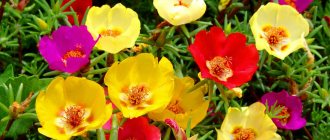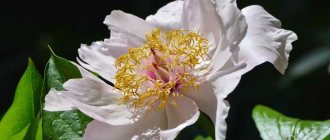With the last ray of sun, the ornamental plant evening primrose (moon flower) awakens in the gardens. After sunset, bright buds bloom on its bushes in a few seconds, emitting a characteristic cotton sound. The plant is valued for its decoration of the night landscape, its ability to heal wounds, treat women's diseases and get rid of excess weight. We invite the reader to learn about growing methods and methods of caring for ornamental crops.
After sunset, bright buds bloom on its bushes in a few seconds
Description, distribution and varieties of evening primrose
Evening primrose (night candle, evening primrose, aspen) is a genus of plants from the fireweed family, which includes about a hundred of its species. In terms of size, its representatives can be tall or short, and in terms of their life cycle - annual, biennial and perennial.
Mostly grown as an ornamental crop, evening primrose grows wild in central North America and temperate European countries.
Depending on the variety, the stem of the plant can be erect or creeping. Its size usually ranges from 30 cm to 2 meters in height, and the leaves are jagged, oval-elongated and lobed in shape. Evening primrose flowers come in white, yellow, pink and, in rare cases, blue. The peculiarity of the varieties of this crop is the short life cycle of the flower, which includes one night, after which a new bud blooms. In cool and cloudy weather, the flower petals remain open all day.
Evening primrose annual and biennial:
- Drummond. An annual plant with a height of 30 to 60 cm with large yellow flowers can produce in the second year after planting.
- Lamarca (Red sepal). The biennial culture has a branching, erect stem up to 100 cm high with bright inflorescences.
- Perennial yellow. A plant with small flowers up to 1.5 cm in diameter is cultivated as a biennial crop.
Evening primrose perennial:
- Missouri. The low-growing species has lodging stems and golden-yellow flowers that smell like citrus.
- Quadrangular. A frost-resistant bushy plant with blue-green or red foliage grows up to 70 cm in height.
- Free wind. The height of the drought-resistant plant with a dense white crown reaches 120 cm.
- Yellow bush. Its bright flowers harmonize perfectly with the reddish-brown leaves.
- Solveig. This species is unpretentious, winter- and drought-resistant.
- Evening primrose is a beautiful orchid pink. A perennial crop with pink flowers does not tolerate cold well and quickly degenerates.
Evening primrose flowers come in white, yellow, and pink colors.
Growing evening primrose from seeds
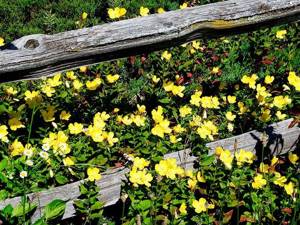
When to sow aspen for growing in open ground depends on the type of flower and your employment:
- In February and March, they sow Night Star seedlings so that the perennials will bloom this season. Annual varieties grown in seedlings will bloom in June.
- In April-May, when the ground thaws, you can sow evening primrose directly into the ground.
- In September-October, donkey forest can be sown before winter. In spring, with the onset of warm days, shoots will appear, and evening primrose will bloom in late spring or early summer.
Attention! Perennial species of aspen bush grow foliage and form a rosette in the first year, and begin to bloom only in the second year after planting.
Sowing evening primrose for seedlings
Growing seedlings does not present any great difficulties. To get strong plants you need to follow a few simple rules:
- Sowing is done in a container or box. The soil is best used for flowers or seedlings. The soil from the site must first be disinfected, for example, with Fitosporin.
- The seeds should be sown to a depth of 0.5-1 cm. The crops are covered with soil on top, moistened and covered with film.
- Containers with crops are placed on a sunny windowsill or near a warm radiator. Every day you need to lift the film for a few minutes and check the soil moisture.
- When the seedlings appear, it is recommended to provide them with lighting so that the seedlings do not stretch out.
- At first, the seedlings are moistened with a spray bottle, preventing the soil from drying out.
- Dense shoots are thinned out after some time. To do this, weak seedlings are selected and cut above the ground.
You will be interested to know: Growing viola from seeds: when to plant, planting and care, types and varieties
Planting seedlings in the ground
When the spring frosts end, evening primrose seedlings are planted in the garden. To do this, choose a sunny area where there is no stagnant water.
The aspen tree is planted in holes at a distance of about half a meter from each other. The distance between the colors depends on the type of Night Candle. Therefore, follow the recommendations written on the packet of seeds.
After planting, be sure to water the evening primrose seedlings and shade them from sunlight for several days.
Chemical composition of oslinnik
The leaves of the plant contain tannins (up to 11%) and macro- and microelements (calcium, potassium, sodium, magnesium, zinc, iron, selenium). The seeds contain up to 25% fatty oil (a mixture of unsaturated fatty acids and triglycerides). Oslinnik roots are rich in proteins, minerals, resins, sterols and starch. Evening primrose seed oil contains vitamin E and gamma-linoleic acid (Omega 6).
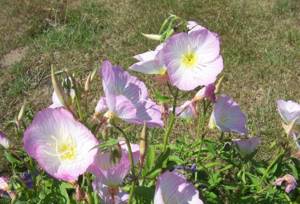
Oslinnik roots are rich in protein and minerals
Application of the plant
In night landscape design, the evening primrose flower is usually used in group compositions. Tall varieties of plants look great next to delphinium, colorful bells, peonies and daylilies. Low varieties of culture effectively complement ageratum and lobelia.
The “moon path” is very popular among gardeners, along which decoratively blooming flowers are planted. Its main decoration is considered to be the evening primrose, illuminated by spotlights or lanterns.
In cosmetology, an extract from evening primrose seeds is used as oil for hair and skin. It successfully eliminates redness of the epidermis, age spots and age wrinkles. Hair masks based on this oil help with hair loss and dandruff.
In cooking, aspen leaves are used to prepare savory soups and meat delicacies. Evening primrose roots are ground raw or boiled into salads. Its seeds are similar in taste to nuts, so they are added to confectionery baked goods. Dark yellow aspen honey with a greenish tint is perfect for soaking cakes and pastries.

In cosmetology, an extract from evening primrose seeds is used as oil for hair and skin.
Evening primrose in landscape design
Landscapers typically include perennial varieties of evening primrose in flower beds to create contrast. Tall varieties look great in the background of group plantings, while creeping varieties look great in the foreground. In addition, it is possible to use aspen wood in alpine slides, flower beds, ridges, and to decorate gazebos, fences and terraces.
The combination of evening primrose with other flowers in the flowerbed
Garden perennial tradescantia - planting and care in open ground
Lunnik goes well with many garden plants, both in appearance and in the structure of the root system. It can be planted near peonies, bellflower, brunnera, daylily thickets, ageratum, alyssum, astilbe, speedwell and delphiniums. The best combinations are obtained with flowers whose petals are lilac, red and white.
Important! The main thing that needs to be taken into account is the ratio of the height of the selected varieties of evening primrose and the neighboring plant, so that they do not block each other.
Medicinal properties and harm
All parts of the aspen tree are useful for humans, but the oil squeezed from its seeds using the cold extraction method is especially valuable. After such treatment, the usefulness of the biologically active substances of the product is preserved.
Evening primrose oil is necessary for women if they develop amenorrhea (lack of menstruation) and mastopathy (benign tumor in the breast area). The drug can be taken by people who want to lose weight by quickly and safely breaking down fats in the body.
There are practically no contraindications for using the plant: it is undesirable to take evening primrose oil, roots and foliage only if you are individually intolerant to their components.
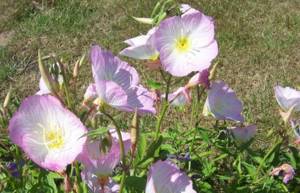
The drug can be taken by people who want to lose weight due to the rapid and safe breakdown of fats
Planting and caring for evening primrose
When choosing soil for an aspen forest, it is advisable to give preference to light sandy soil with an acidity of 5.5 - 7. The plant will also take root in dry soils, but they must be thoroughly drained.
Small seeds (taking into account 3 tons of seeds per 1 ha) are planted in autumn in holes 2-3 mm deep at a distance of 10 to 100 cm from each other and lightly sprinkled with damp soil. If we are not talking about open ground, then the temperature in the sowing room should be about 21 °C. After 7 days, when irrigating the land by sprinkling every day, the first shoots will appear. By the end of autumn, rosettes of leaves are formed that tolerate frost well. To be on the safe side, you can cover them with film or fallen leaves.
In the spring, you need to carry out foliar feeding using organo-mineral mixtures, Energen or GumatEM. At home, they are replaced with an effective recipe: 1 tsp. ash is poured into 1 liter of boiling water and left for 24 hours.
Evening primrose tolerates dry periods well, so it should be watered no more than once every 2 to 3 weeks.
The main thing is to ensure the flow of air to the roots of the decorative crop using loosening. Plant propagation occurs vegetatively by separating shoots from the mother bush.
Diseases and pests of evening primrose do not cause problems for gardeners. In rare cases, it is necessary to spray the bushes against aphids and remove the damaged part of the plant due to fungus.
Care
Evening primrose will not bring much trouble to its owners. It is quite light-loving, but can also grow in partial shade. There are no special requirements for the composition of the soil. The main thing is to ensure good drainage for oxygen supply.
Faded inflorescences are periodically removed. To prevent weeds from interfering with the growth of the night violet, they are removed from time to time. For tall varieties, side shoots should be shortened by half. In this case, the plant acquires splendor and looks neater.
The soil should not be allowed to dry out, but it should not be over-watered either. Excessive moisture contributes to rotting of the rhizome. Daily watering is provided during planting and during the period of active growth.
Many species tolerate winter well, but in severe frosts they need shelter. To do this, the above-ground part is cut directly under the root, and the top is sprinkled with a mixture of sawdust and leaves or spruce branches.
High-quality video material from Yana Fedorova. The plant in her garden grows almost on its own and requires no care at all, except for weeding:
Recipes with the plant
Recipes using oslinnik will help with the following diseases:
- Cystitis. 1 tbsp. l. crushed leaves and flowers are mixed with a collection of herbs from medicinal plants (parsley, star anise), pour 200 ml of boiling water and keep in a warm place for 2 hours. The infusion is taken throughout the day until pain during urination is eliminated.
- Amenorrhea. 1 tsp. crushed seeds, pour 150 ml of hot water and leave for an hour. The product is drunk 3 times a day for a week. After a two-week break, the course is repeated.
- Wounds on the body. 2 tbsp. l. Finely chopped evening primrose roots are poured into 250 ml of boiling water and simmered over low heat for 15 minutes. Sterile gauze is moistened with the strained broth, applied to the wound and secured with a band-aid. The lotion is changed as it dries.
Instead of contemplating photos of flower beds in a flowerbed, it is better to admire the evening primrose grown with your own hands in the evenings. For all its beauty, the plant is useful for treating many diseases at home and when preparing delicious dishes.
Correct fit

But it won’t hurt to familiarize yourself with the rules for growing such plants. When choosing a planting location, you need to consider the lighting location. Despite the fact that evening primrose grows in any type of light, it may not bloom in strong shade. Therefore, the right place would be partial shade or a flowerbed under bright sun.
Like many plants, evening primrose loves good, fresh and nutritious soil. Before planting a perennial flower, care is taken to improve and fertilize the soil. For 1 sq. m. add 2 cups of nitrophoska, 3 kg of humus or the same amount of compost. 24 hours before planting, the soil is well moistened and not dug too deeply.
Evening primrose seeds can be planted directly into the ground, but in this case they will bloom only the next year. The seed is mixed with sand and placed at a shallow depth. If you take care of the flowers in February and plant them in seedlings, you will be able to admire the flowers this year. Seedlings are planted in May after the threat of frost in separate holes 15 by 25 cm.
Flower care
Evening primrose is indifferent to water and calmly tolerates arid climates. It is recommended to do 2 deep waterings per season, for this purpose per 1 sq. m. pour out about two buckets of water.
An adult plant does not allow itself to be crushed by weeds, but only the planted and young flowers need help. Weeding and mulching should be done as weeds appear. At the same time, they loosen the soil and tie up tall varieties of plants for better preservation.
Evening primrose does not need additional fertilizers, but once a season during flowering you can please it with this infusion: 1 tbsp. l. potassium sulfate and 1 tbsp. l. superphosphate per 1 sq. m. of soil. Both wood ash and nitrophoska at the time of bud ripening are suitable.
It is not recommended to trim faded stems, as they do not affect the growth of the plant and the duration of flowering. But for the aesthetic appearance of the composition, the dried parts of the plant are removed. Planned pruning of perennial plants is carried out in the fall. Cut off the entire above-ground part of the flower down to the root system.
In the first year, perennial evening primrose is covered with dry leaves or spruce branches for the winter. In the following seasons, immediately after removing the ground layer, fill the soil with peat or compost to a height of about 5 cm.
Frequent pests for the plant are fungal diseases and aphids. Since evening primrose is a strong flower, it is enough to remove the affected leaves and let it cope with the disease on its own. When infested by pests, spray with insecticides at the time of detection.
Reproduction and transplantation
The division of the flower is carried out in May or September. To do this, use good, strong and large plants with powerful root systems.
About once every four years, the bushes are divided and transplanted to another place for better growth and flowering . This process is called plant rejuvenation. To do it correctly, take good bushes and divide them into several parts, trying not to damage the root system. They are planted in a new habitat and fed with fertilizers as needed.
The unpretentious perennial yellow evening primrose will decorate any flower bed or garden. Just remember to fertilize, water and plant the plant in a timely manner.
